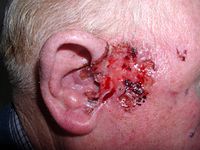
Photo from wikipedia
A 73-year-old man was referred to our hospital for treatment of a superficial nonampullary duodenal epithelial tumor (SNADET). The tumor was a reddish and depressed lesion in the center, measuring… Click to show full abstract
A 73-year-old man was referred to our hospital for treatment of a superficial nonampullary duodenal epithelial tumor (SNADET). The tumor was a reddish and depressed lesion in the center, measuring 10mm in diameter, and located in the superior duodenal angle (▶Fig. 1 a, b). Magnifying endoscopy with narrow-band imaging (ME-NBI) showed a disappearance of microsurface pattern and irregular corkscrew microvascular pattern on the surface within the depressed area (▶Fig. 1 c). Subsequently, the lesion was stained with a mixture of 0.05% crystal violet and 0.1% methylene blue, followed by endocytoscopic observation. Endocytoscopy showed no formation of glandular lumen, only nuclear swelling visualized with methylene blue (▶Fig. 1d). We diagnosed SNADET with a component of signet-ring cell carcinoma, and endoscopic submucosal dissection (ESD) was planned for the purpose of en bloc resection. ESD was performed using the DualKnife (Olympus, Tokyo, Japan) and the ulcer floor after ESD was completely closed with an over-the-scope clip (Ovesco Endoscopy GmbH, Tübingen, Germany) (▶Video 1). The total procedure time was 30min without adverse events. Histopathological examination confirmed the diagnosis of signet-ring cell carcinoma, partially mixed with moderately and well-differentiated adenocarcinomas. In the depressed area, the mucosal layer was occupied by signet-ring cells up to the surface, and the findings of ME-NBI and endocytoscopy were considered to be consistent with signet-ring cell carcinoma (▶Fig. 2). Additional surgery was recommended because the carcinoma had invaded the submucosa, but the patient requested follow-up.One year after ESD, there was no sign of recurrence. Signet-ring cell carcinoma of the duodenum is rare [1, 2], but even among these, the frequency of signet-ring cell carcinoma in SNADET is extremely low, with only few reports of early cancer detection [3]. This is the first case in which detailed observation could be obtained, especially by ME-NBI and endocytoscopy, and it is expected to play a very important role in future endoscopic diagnosis in the duodenum.
Journal Title: Endoscopy
Year Published: 2022
Link to full text (if available)
Share on Social Media: Sign Up to like & get
recommendations!